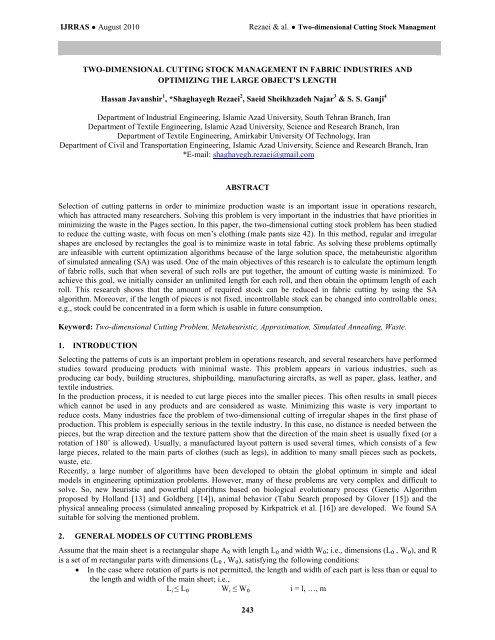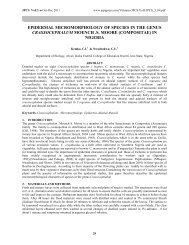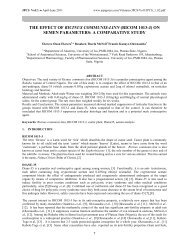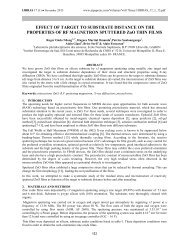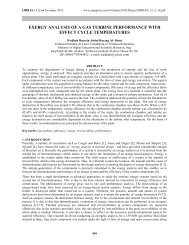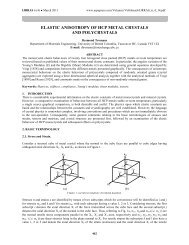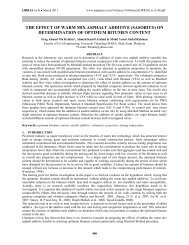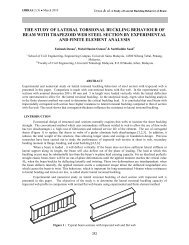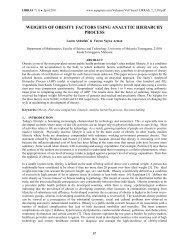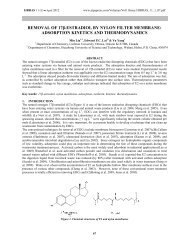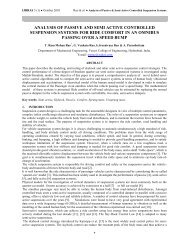Two-Dimensional Cutting Stock Management in Fabric Industries ...
Two-Dimensional Cutting Stock Management in Fabric Industries ...
Two-Dimensional Cutting Stock Management in Fabric Industries ...
You also want an ePaper? Increase the reach of your titles
YUMPU automatically turns print PDFs into web optimized ePapers that Google loves.
IJRRAS ● August 2010 Rezaei & al. ● <strong>Two</strong>-dimensional <strong>Cutt<strong>in</strong>g</strong> <strong>Stock</strong> Managment<br />
TWO-DIMENSIONAL CUTTING STOCK MANAGEMENT IN FABRIC INDUSTRIES AND<br />
OPTIMIZING THE LARGE OBJECT'S LENGTH<br />
Hassan Javanshir 1 , *Shaghayegh Rezaei 2 , Saeid Sheikhzadeh Najar 3 & S. S. Ganji 4<br />
Department of Industrial Eng<strong>in</strong>eer<strong>in</strong>g, Islamic Azad University, South Tehran Branch, Iran<br />
Department of Textile Eng<strong>in</strong>eer<strong>in</strong>g, Islamic Azad University, Science and Research Branch, Iran<br />
Department of Textile Eng<strong>in</strong>eer<strong>in</strong>g, Amirkabir University Of Technology, Iran<br />
Department of Civil and Transportation Eng<strong>in</strong>eer<strong>in</strong>g, Islamic Azad University, Science and Research Branch, Iran<br />
*E-mail: shaghayegh.rezaei@gmail.com<br />
ABSTRACT<br />
Selection of cutt<strong>in</strong>g patterns <strong>in</strong> order to m<strong>in</strong>imize production waste is an important issue <strong>in</strong> operations research,<br />
which has attracted many researchers. Solv<strong>in</strong>g this problem is very important <strong>in</strong> the <strong>in</strong>dustries that have priorities <strong>in</strong><br />
m<strong>in</strong>imiz<strong>in</strong>g the waste <strong>in</strong> the Pages section. In this paper, the two-dimensional cutt<strong>in</strong>g stock problem has been studied<br />
to reduce the cutt<strong>in</strong>g waste, with focus on men’s cloth<strong>in</strong>g (male pants size 42). In this method, regular and irregular<br />
shapes are enclosed by rectangles the goal is to m<strong>in</strong>imize waste <strong>in</strong> total fabric. As solv<strong>in</strong>g these problems optimally<br />
are <strong>in</strong>feasible with current optimization algorithms because of the large solution space, the metaheuristic algorithm<br />
of simulated anneal<strong>in</strong>g (SA) was used. One of the ma<strong>in</strong> objectives of this research is to calculate the optimum length<br />
of fabric rolls, such that when several of such rolls are put together, the amount of cutt<strong>in</strong>g waste is m<strong>in</strong>imized. To<br />
achieve this goal, we <strong>in</strong>itially consider an unlimited length for each roll, and then obta<strong>in</strong> the optimum length of each<br />
roll. This research shows that the amount of required stock can be reduced <strong>in</strong> fabric cutt<strong>in</strong>g by us<strong>in</strong>g the SA<br />
algorithm. Moreover, if the length of pieces is not fixed, <strong>in</strong>controllable stock can be changed <strong>in</strong>to controllable ones;<br />
e.g., stock could be concentrated <strong>in</strong> a form which is usable <strong>in</strong> future consumption.<br />
Keyword: <strong>Two</strong>-dimensional <strong>Cutt<strong>in</strong>g</strong> Problem, Metaheuristic, Approximation, Simulated Anneal<strong>in</strong>g, Waste.<br />
1. INTRODUCTION<br />
Select<strong>in</strong>g the patterns of cuts is an important problem <strong>in</strong> operations research, and several researchers have performed<br />
studies toward produc<strong>in</strong>g products with m<strong>in</strong>imal waste. This problem appears <strong>in</strong> various <strong>in</strong>dustries, such as<br />
produc<strong>in</strong>g car body, build<strong>in</strong>g structures, shipbuild<strong>in</strong>g, manufactur<strong>in</strong>g aircrafts, as well as paper, glass, leather, and<br />
textile <strong>in</strong>dustries.<br />
In the production process, it is needed to cut large pieces <strong>in</strong>to the smaller pieces. This often results <strong>in</strong> small pieces<br />
which cannot be used <strong>in</strong> any products and are considered as waste. M<strong>in</strong>imiz<strong>in</strong>g this waste is very important to<br />
reduce costs. Many <strong>in</strong>dustries face the problem of two-dimensional cutt<strong>in</strong>g of irregular shapes <strong>in</strong> the first phase of<br />
production. This problem is especially serious <strong>in</strong> the textile <strong>in</strong>dustry. In this case, no distance is needed between the<br />
pieces, but the wrap direction and the texture pattern show that the direction of the ma<strong>in</strong> sheet is usually fixed (or a<br />
rotation of 180˚ is allowed). Usually, a manufactured layout pattern is used several times, which consists of a few<br />
large pieces, related to the ma<strong>in</strong> parts of clothes (such as legs), <strong>in</strong> addition to many small pieces such as pockets,<br />
waste, etc.<br />
Recently, a large number of algorithms have been developed to obta<strong>in</strong> the global optimum <strong>in</strong> simple and ideal<br />
models <strong>in</strong> eng<strong>in</strong>eer<strong>in</strong>g optimization problems. However, many of these problems are very complex and difficult to<br />
solve. So, new heuristic and powerful algorithms based on biological evolutionary process (Genetic Algorithm<br />
proposed by Holland [13] and Goldberg [14]), animal behavior (Tabu Search proposed by Glover [15]) and the<br />
physical anneal<strong>in</strong>g process (simulated anneal<strong>in</strong>g proposed by Kirkpatrick et al. [16]) are developed. We found SA<br />
suitable for solv<strong>in</strong>g the mentioned problem.<br />
2. GENERAL MODELS OF CUTTING PROBLEMS<br />
Assume that the ma<strong>in</strong> sheet is a rectangular shape A₀ with length L₀ and width W₀; i.e., dimensions (L ₀ , W₀), and R<br />
is a set of m rectangular parts with dimensions (L ₀ , W₀), satisfy<strong>in</strong>g the follow<strong>in</strong>g conditions:<br />
In the case where rotation of parts is not permitted, the length and width of each part is less than or equal to<br />
the length and width of the ma<strong>in</strong> sheet; i.e.,<br />
Li ≤ L₀ Wi ≤ W₀ i = l, …, m<br />
243
IJRRAS ● August 2010 Rezaei & al. ● <strong>Two</strong>-dimensional <strong>Cutt<strong>in</strong>g</strong> <strong>Stock</strong> Managment<br />
In the case where rotation of parts is permitted, the largest dimension of each piece is less than or equal to<br />
that of the ma<strong>in</strong> sheet, and similarly, the smallest dimension of each piece is less than or equal to that of<br />
ma<strong>in</strong> sheet; i.e.,<br />
max (Li,Wi) ≤ max (L₀,W₀) and m<strong>in</strong> (Li,Wi) ≤ m<strong>in</strong> (L₀,W₀)<br />
(In this work, rotation of parts is not permitted as is stated <strong>in</strong> the assumptions.)<br />
Now the problem is to cut a ma<strong>in</strong> sheet A₀ such that the total value of the result<strong>in</strong>g parts is maximized, while, for<br />
each i, at least one and at most bi copies of piece i is generated. The general form of this problem is as follows [2]:<br />
Max Z = ∑ vi . xi<br />
s.t.<br />
0 <br />
X i bi<br />
244<br />
i<br />
Integer: xi i = l, …,m<br />
In this formulation, xi is the decision variable <strong>in</strong>dicat<strong>in</strong>g the number of copies of the i th piece if the i th item is cut<br />
from A₀.<br />
In the case with demands, it is assumed that we have an unlimited number of large rectangular sheets A₀ with<br />
dimensions (L₀,W₀) as well as a set R consist<strong>in</strong>g of m small rectangular part R={(Li,Wi) i=l,…,m}. In<br />
addition, <strong>in</strong>dicate the m<strong>in</strong>imum required number of copies of the i th piece and the usage cost of the j th cutt<strong>in</strong>g<br />
method are denoted, respectively, by Ni and Cj. The result<strong>in</strong>g optimization problem will have the form [3]:<br />
M<strong>in</strong> Z = n ∑ Cj . xj<br />
j=<br />
¹<br />
s.t.<br />
i= ¹<br />
m<br />
n<br />
∑ aij . xj ≥ Ni i = l,...., m<br />
j=<br />
¹<br />
Integer and xj ≥ j = l,...,n<br />
In this model, xj <strong>in</strong>dicates the number of ma<strong>in</strong> sheets which are cut accord<strong>in</strong>g to the jth cutt<strong>in</strong>g method, aij <strong>in</strong>dicates<br />
the number of copies of the i th piece produced by cutt<strong>in</strong>g a ma<strong>in</strong> sheet accord<strong>in</strong>g to the j th cutt<strong>in</strong>g, and m and n are<br />
the total numbers of piece types and cutt<strong>in</strong>g methods, respectively.<br />
The above model is not sufficient to describe the cutt<strong>in</strong>g problem, because it does not conta<strong>in</strong> explicit constra<strong>in</strong>ts on<br />
the layout of pieces <strong>in</strong> the sheets, forbidd<strong>in</strong>g the pieces from hav<strong>in</strong>g overlaps <strong>in</strong> each sheet. Also there aren’t any<br />
variables show<strong>in</strong>g the position of the pieces <strong>in</strong> each sheet. In this model at the beg<strong>in</strong>n<strong>in</strong>g cutt<strong>in</strong>g methods should be<br />
identified so that the model could choose a comb<strong>in</strong>ation of cutt<strong>in</strong>g methods to have the least possible waste.<br />
2-1- Model Assumptions<br />
The assumptions and constra<strong>in</strong>ts of the studied cutt<strong>in</strong>g problem are as follows:<br />
The required patterns and the ma<strong>in</strong> sheets have rectangular shape (or more precisely, it’s assumed that the<br />
required pieces are enclosed by rectangulars).<br />
The ma<strong>in</strong> sheets are identical and are available with unlimited length.<br />
The ma<strong>in</strong> sheets are homogeneous and even, and there whole surface is usable and free of defects.<br />
The cutt<strong>in</strong>g of fabric is Guillot<strong>in</strong>e and cutt<strong>in</strong>g of patterns is non-Guillot<strong>in</strong>e. A Guillot<strong>in</strong>e cut is one which<br />
starts from one side of the rectangular sheet and term<strong>in</strong>ates at the opposite side [1].<br />
All examples have been developed for male pants size 42.<br />
Patterns <strong>in</strong> this algorithm are arranged as wrapp<strong>in</strong>g; which is, no rotation is permitted.<br />
The width of the sheet is specified, but it length is unlimited (<strong>Fabric</strong> width is considered 150 cm).<br />
There are no limitations on the m<strong>in</strong>imum and maximum numbers of copies of each piece produced from a<br />
ma<strong>in</strong> blot.<br />
The free edge of fabric is <strong>in</strong>cluded <strong>in</strong> rectangulars, and the cutt<strong>in</strong>g l<strong>in</strong>es have zero width.<br />
The coord<strong>in</strong>ates of the located pieces are expressed with respect to the orig<strong>in</strong>, which is at the lower-left<br />
corner of the ma<strong>in</strong> sheet.<br />
(1)<br />
(2)
IJRRAS ● August 2010 Rezaei & al. ● <strong>Two</strong>-dimensional <strong>Cutt<strong>in</strong>g</strong> <strong>Stock</strong> Managment<br />
3. METHOD OF CHANGING IRREGULAR SHAPES TO REGULAR ONES<br />
In this phase, different parts of male pants of size 42 with irregular shapes are enclosed by rectangular shapes <strong>in</strong><br />
order to be changed <strong>in</strong>to regular shapes. Then, regular rectangular are arranged by different arrangement only <strong>in</strong> the<br />
wrap direction (without rotation), show<strong>in</strong>g different lengths with different amounts of waste. The details of this<br />
procedure are expla<strong>in</strong>ed <strong>in</strong> the follow<strong>in</strong>g.<br />
Figure 1- chang<strong>in</strong>g irregular shape to regular one<br />
In the cutt<strong>in</strong>g problem, when items are cut from large pieces, some parts may not be used, because there are many<br />
choices for cutt<strong>in</strong>g of different patterns by the user. Therefore, different choices for cutt<strong>in</strong>g will result <strong>in</strong> different<br />
amounts of waste. In the cutt<strong>in</strong>g problem studied <strong>in</strong> operation research, the objective function is usually def<strong>in</strong>ed as<br />
m<strong>in</strong>imiz<strong>in</strong>g the number of cutt<strong>in</strong>g patterns. But overall, the f<strong>in</strong>al objective is to m<strong>in</strong>imize the total waste.<br />
4. DEFINITION OF PARAMETERS<br />
To provide a more accurate description of our approach to the cutt<strong>in</strong>g problem, these parameters are <strong>in</strong>troduced to<br />
expla<strong>in</strong> the cutt<strong>in</strong>g stock problem:<br />
i = The number of items (pants)<br />
j = The number of rolls (fabric sheets) j = 1 , 2 , 000,m<br />
li = The length of the i th ordered item n ,000 , 2 , 1 = i<br />
y = Width of fabric (fix and 150cm)<br />
S = Item’s area<br />
n = The number of ordered item<br />
m = The number of rolls be<strong>in</strong>g used<br />
Wj = Waste <strong>in</strong> each roll<br />
W = Total waste<br />
Us<strong>in</strong>g the parameters above, we can calculate the cutt<strong>in</strong>g waste as<br />
Wj = ( li * y ) – ( i * S )<br />
0 ≤ Wj< S<br />
j<br />
=<br />
1<br />
,<br />
2<br />
,… ,<br />
m<br />
As mentioned previously, there are large numbers of possible values for Wj <strong>in</strong> optimum result of a cutt<strong>in</strong>g model,<br />
while all these results satisfy the constra<strong>in</strong>t<br />
245<br />
(3)
IJRRAS ● August 2010 Rezaei & al. ● <strong>Two</strong>-dimensional <strong>Cutt<strong>in</strong>g</strong> <strong>Stock</strong> Managment<br />
M<br />
<br />
j1<br />
w<br />
j <br />
W<br />
In the cutt<strong>in</strong>g stock problem, among all possible solutions, we are <strong>in</strong>terested <strong>in</strong> the one which corresponds to the<br />
smallest number of rolls conta<strong>in</strong><strong>in</strong>g waste.<br />
5. PROBLEM CONSTRAINTS<br />
In this problem, two constra<strong>in</strong>ts are considered:<br />
1) The cutt<strong>in</strong>g length: The maximum length of each roll is considered to be 5 meters.<br />
li ≤ 5<br />
2) Deterioration: The waste <strong>in</strong> the each step cannot be more than the previous step<br />
Wi ≥ Wi+1<br />
In this paper, as noted <strong>in</strong> the assumptions, it is assumed that the lengths of fabrics from which the patterns (pieces)<br />
are cut are unlimited. This makes the problem different from those studied so far <strong>in</strong> the literature.<br />
As mentioned previously <strong>in</strong> Section 2, general cutt<strong>in</strong>g models are not sufficient to describe the cutt<strong>in</strong>g problem,<br />
s<strong>in</strong>ce they do not <strong>in</strong>clude variables <strong>in</strong>dicat<strong>in</strong>g the location of pieces and constra<strong>in</strong>ts on their arrangements. Instead,<br />
one needs to identify different comb<strong>in</strong>ations of cutt<strong>in</strong>g styles and choose a comb<strong>in</strong>ation with m<strong>in</strong>imum waste.<br />
However, s<strong>in</strong>ce there are an extremely large number of possible cutt<strong>in</strong>g styles, it is not feasible to utilize and directly<br />
solve the aforementioned model. In this paper, <strong>in</strong> order to achieve a near-optimum solution, we have used simulated<br />
anneal<strong>in</strong>g, which is one of the most commonly-used metaheuristic algorithms.<br />
6. SOLVING USING SIMULATED ANNEALING<br />
Simulated anneal<strong>in</strong>g is a technique <strong>in</strong>spired by the natural process of anneal<strong>in</strong>g solids. The physical process of<br />
anneal<strong>in</strong>g is the cool<strong>in</strong>g of a metal sufficiently slowly so that it adopts a low-energy, crystall<strong>in</strong>e state. When the<br />
temperature of the metal is high, the particles with<strong>in</strong> the metal are able to move around, chang<strong>in</strong>g the structure of the<br />
metal, freely. As the temperature is lowered, the particles are limited <strong>in</strong> the movements they can make as many<br />
movements have a high energy cost and are <strong>in</strong>creas<strong>in</strong>gly limited to only those configurations with lower energy than<br />
the previous state. Simulated anneal<strong>in</strong>g draws <strong>in</strong>spiration from the physical process, <strong>in</strong> a computational model of the<br />
physical system [12].<br />
In the follow<strong>in</strong>g, we present the simulated anneal<strong>in</strong>g method to solve the two-dimensional cutt<strong>in</strong>g stock problem of<br />
fabric.<br />
6-1- Objective function def<strong>in</strong>ition<br />
The objective is def<strong>in</strong>ed as m<strong>in</strong>imiz<strong>in</strong>g the total waste value. The total waste value is calculated as follows:<br />
m<br />
M<strong>in</strong> Z= ∑ [ ( li * y) – ( i * S)]<br />
j=1 (5)<br />
j<br />
=<br />
1<br />
,<br />
2<br />
,000,<br />
6-2- Initial solution<br />
m<br />
An <strong>in</strong>itial solution is needed to start the SA process. The quality of this <strong>in</strong>itial solution has a significant effect on the<br />
search<strong>in</strong>g process of SA. In other words, if the <strong>in</strong>itial solution corresponds to a good quality of the objective<br />
function, the process to achieve an optimum or near optimum solution of the problem may have a better<br />
performance, and <strong>in</strong> many cases, a higher speed.<br />
To f<strong>in</strong>d a good <strong>in</strong>itial solution, we started to layout the parts from the reference po<strong>in</strong>t (left side and bottom angle of<br />
each rectangular <strong>in</strong> each fabric).<br />
246<br />
(4)
IJRRAS ● August 2010 Rezaei & al. ● <strong>Two</strong>-dimensional <strong>Cutt<strong>in</strong>g</strong> <strong>Stock</strong> Managment<br />
6-3- Neighborhood generation<br />
In order to generate a neighborhood solution, a random state will be used. In this state, us<strong>in</strong>g random selection, the<br />
item orders are change algorithmically. The steps of this algorithm are expla<strong>in</strong>ed below:<br />
Step1. Number the available small items <strong>in</strong> <strong>in</strong>itial solution from 1 to N.<br />
Step2. Generate a uniform random number R1 <strong>in</strong> the range [2, N] def<strong>in</strong><strong>in</strong>g the number of displacements of items.<br />
Step3. Generate R1 uniform random numbers Ri : i = 1 ,…,N <strong>in</strong> the range [1,N], def<strong>in</strong><strong>in</strong>g the <strong>in</strong>dices of displaced<br />
items.<br />
Step4. If the i th and ( i +1) th item have the same length, avoid displacement; otherwise, swap the i th and ( i +1) th<br />
items.<br />
6-4- Simulated Anneal<strong>in</strong>g procedure<br />
After determ<strong>in</strong><strong>in</strong>g the neighborhood solution, the value of the Boltzmann function will be computed as follows:<br />
Δ = Z2 – Z1<br />
(6)<br />
Z1 = waste <strong>in</strong> <strong>in</strong>itial solution<br />
Z2 = waste <strong>in</strong> neighborhood solution<br />
- Δ/T<br />
Boltzmann function = e<br />
If Δ
IJRRAS ● August 2010 Rezaei & al. ● <strong>Two</strong>-dimensional <strong>Cutt<strong>in</strong>g</strong> <strong>Stock</strong> Managment<br />
In the studied examples, the algorithm was term<strong>in</strong>ated based on the first condition before meet<strong>in</strong>g the second<br />
term<strong>in</strong>ation condition of the algorithm. .However, <strong>in</strong> order to evaluate the amount of waste <strong>in</strong> cutt<strong>in</strong>g process, we<br />
considered another variation where the first term<strong>in</strong>ation condition was ignored and we <strong>in</strong>vestigated a number of<br />
different cases.<br />
As described <strong>in</strong> table 1, the waste was controlled <strong>in</strong> order to make a proper decision <strong>in</strong> case of a sudden change.<br />
Table 1- Review the best condition with 10pants<br />
The results based on the second term<strong>in</strong>ation condition are shown <strong>in</strong> Figure 2.<br />
Figure 2- Achieve to the second stop condition and stop the problem<br />
As shown <strong>in</strong> Figure 2, percentage of waste for 7 pants 0.61% is higher than that for 6 pants, and the algorithm<br />
stopped at 7 pants.<br />
8. CONCLUSION<br />
The algorithm was stopped because the<br />
situation will be worse <strong>in</strong> 7 pants. It means<br />
that reached to second stop condition.<br />
In this paper we studied the two-dimensional cutt<strong>in</strong>g stock problem to reduce cutt<strong>in</strong>g stock. Most of researchers<br />
have studied cutt<strong>in</strong>g stock problems with the aim of reduc<strong>in</strong>g waste <strong>in</strong> the sheet with specified length and width.<br />
But <strong>in</strong> this research, only the width is specified and an unlimited length is assumed for the fabric from which the<br />
pieces were cut. This turns uncontrollable wastes <strong>in</strong>to controllable ones with displacement of the length,<br />
dist<strong>in</strong>guish<strong>in</strong>g the studied method is different from those studied until now.<br />
It is difficult and impractical to utilize a general model for the problem, s<strong>in</strong>ce there is an extremely large number<br />
of comb<strong>in</strong>ations of cutt<strong>in</strong>g styles. In such problems, to achieve the near optimum solution, simulated anneal<strong>in</strong>g is<br />
one of the most effective metaheuristic algorithms<br />
248
IJRRAS ● August 2010 Rezaei & al. ● <strong>Two</strong>-dimensional <strong>Cutt<strong>in</strong>g</strong> <strong>Stock</strong> Managment<br />
This research has been done on men’s cloth<strong>in</strong>g (male pants size 42) and the patterns were enclosed by rectangular<br />
shapes and irregular shapes changed to regular one. To obta<strong>in</strong> numerical result <strong>in</strong> this research, we assume unlimited<br />
length of fabric, and <strong>in</strong>controllable waste was changed <strong>in</strong>to controllable and concentrated ones, which can be used <strong>in</strong><br />
future consumptions.<br />
9. REFERENCES<br />
[1] Alan, R. M.J., Shang, J. and Kuppusamy, S., 2006, "Simulated anneal<strong>in</strong>g heuristics for the dynamic facility<br />
layout problem", Computers & Operations Research, 33, 2431-2444.<br />
[2] Beasley, J.E, 1985, “Algorithms for Unconstra<strong>in</strong>d <strong>Two</strong> <strong>Dimensional</strong> Guillot<strong>in</strong>e <strong>Cutt<strong>in</strong>g</strong>,” Operations. Research<br />
Society, 36 (4), 297-306.<br />
[3] Gilmore, P.C. and Gomory, R.E., 1963, A l<strong>in</strong>ear programm<strong>in</strong>g approach to the cutt<strong>in</strong>g stock problem-part II-<br />
Operation Research, 11, 863-888<br />
[4] Karelahti, J., 2002, Solv<strong>in</strong>g the <strong>Cutt<strong>in</strong>g</strong> <strong>Stock</strong> Problem <strong>in</strong> the Steel Industry. Hels<strong>in</strong>ki University of Technology,<br />
1-39.<br />
[5] Kirkpatrick, S., Gelatt, C. D., Vecchi, M. P., 1999. Optimization by Simulated Anneal<strong>in</strong>g, Science, 220 , 671-<br />
680<br />
[6] Maniezzo, V., and Carbonaro, A. 1999. Ant colony optimization: an overview. Knowledgen and Data<br />
Eng<strong>in</strong>eer<strong>in</strong>g, 11, 769–778.<br />
[7] Michalewicz, Z., 1994. Evolutionary computation techniques for nonl<strong>in</strong>ear programm<strong>in</strong>g problems. International<br />
Transactions of Operational Research, 1, 223–240.<br />
[8] Umetani, S. and Yagiura M., An LP-based Local Search for One <strong>Dimensional</strong> <strong>Cutt<strong>in</strong>g</strong> <strong>Stock</strong> Problem. The Fifth<br />
Metaheuristics International Conference.<br />
[9] Sta<strong>in</strong>ton, R. S. 1977. The cutt<strong>in</strong>g stock problem for the stockholder of steel re<strong>in</strong>forcement bars. Operational<br />
Research Quarterly, 28, 139–149.<br />
[10] Tavakkoli-Moghaddam, R., Safaei, N. and Shariat, M.A.., 2005, A multi-criteria vehicle rout<strong>in</strong>g problem with<br />
soft time w<strong>in</strong>dows by simulated anneal<strong>in</strong>g, International Journal of Industrial Eng<strong>in</strong>eer<strong>in</strong>g, 1(1), 28-36.<br />
[11] Aarts E. and Korst J, 1989, Simulated anneal<strong>in</strong>g and boltzmann mach<strong>in</strong>es: a stochastic approach to<br />
comb<strong>in</strong>atorial optimization and neural comput<strong>in</strong>g , Wiley, Chichester<br />
[12] Smith K. I., 2006, A Study of Simulated Anneal<strong>in</strong>g Techniques for Multi-Objective Optimization, University<br />
of Exeter, PhD Thesis.<br />
[13] Holland, J. H., 1975, Adaptation <strong>in</strong> Natural and Artificial Systems, University of Michigan Press, Ann Arbor,<br />
MI.<br />
[14] Goldberg, D.E, 1975, Genetic Algorithms <strong>in</strong> Search, Optimization and Mach<strong>in</strong>e Learn<strong>in</strong>g, Addison Wesley,<br />
Boston, MA.<br />
[15] Glover, F., 1977, Heuristic for <strong>in</strong>teger programm<strong>in</strong>g us<strong>in</strong>g surrogate constra<strong>in</strong>ts, Decision Sciences, 8 (1) 156–<br />
166.<br />
[16] Kirkpatrick, S., Gelatt, C. and Vecchi, M., 1983, Optimization by simulated anneal<strong>in</strong>g, Science 220 (4598),<br />
671–680.<br />
249


